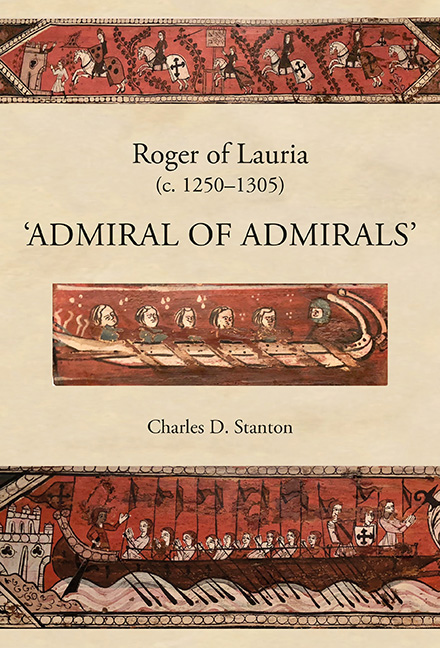Book contents
- Frontmatter
- Dedication
- Contents
- List of Illustrations
- Prologue
- 1 Battle of Benevento (26 February 1266)
- 2 A Calabrian Exile in the Court of Aragon (1262–1282)
- 3 Battle of Tagliacozzo (23 August 1268)
- 4 Aragonese Expansion (1229–1282)
- 5 Angevin Consolidation and Aggrandizement (1268–1282)
- 6 Revolt of the Vespers (30 March 1282)
- 7 Aragonese Intervention (August–October 1282)
- 8 Stalemate (November 1282–March 1283)
- 9 Admiral of Aragon (20 April 1283)
- 10 The Opposing Fleets (1282–1302)
- 11 Battle of Malta (8 June 1283)
- 12 Anjou's Dreams of Empire Dashed (June–November 1284)
- 13 France's Crusade Against Aragon (May–November 1285)
- 14 Battle of the Counts (23 June 1287)
- 15 Truces and Treaties (June 1287–November 1291)
- 16 Raid on Romania (Summer 1292)
- 17 Switching Sides (December 1293–April 1297)
- 18 Aragon's Invasion of Sicily at Anjou's Bidding (1298/1299)
- 19 Lauria's Last Great Campaign (Summer 1299–Spring 1300)
- 20 Endgame (Spring 1301–Summer 1302)
- Epilogue
- Bibliography
- Index
17 - Switching Sides (December 1293–April 1297)
Published online by Cambridge University Press: 24 October 2019
- Frontmatter
- Dedication
- Contents
- List of Illustrations
- Prologue
- 1 Battle of Benevento (26 February 1266)
- 2 A Calabrian Exile in the Court of Aragon (1262–1282)
- 3 Battle of Tagliacozzo (23 August 1268)
- 4 Aragonese Expansion (1229–1282)
- 5 Angevin Consolidation and Aggrandizement (1268–1282)
- 6 Revolt of the Vespers (30 March 1282)
- 7 Aragonese Intervention (August–October 1282)
- 8 Stalemate (November 1282–March 1283)
- 9 Admiral of Aragon (20 April 1283)
- 10 The Opposing Fleets (1282–1302)
- 11 Battle of Malta (8 June 1283)
- 12 Anjou's Dreams of Empire Dashed (June–November 1284)
- 13 France's Crusade Against Aragon (May–November 1285)
- 14 Battle of the Counts (23 June 1287)
- 15 Truces and Treaties (June 1287–November 1291)
- 16 Raid on Romania (Summer 1292)
- 17 Switching Sides (December 1293–April 1297)
- 18 Aragon's Invasion of Sicily at Anjou's Bidding (1298/1299)
- 19 Lauria's Last Great Campaign (Summer 1299–Spring 1300)
- 20 Endgame (Spring 1301–Summer 1302)
- Epilogue
- Bibliography
- Index
Summary
IF THE ADMIRAL OF ARAGON had, in fact, intended to intimidate the Angevins with his actions in the summer of 1292, he succeeded admirably. Shortly after Roger's return from the raid on ‘Romania’ in the early autumn, rumours reached Charles II of Naples that Lauria was planning an ambitious assault on the Amalfi coast, ostensibly to punish Positano and other nearby ports for the harassment of Sicilian shipping. At least forty vessels and 2,000 almugavars as well as an equal number of Messinese mariners were reported to be involved. The ultimate objective, however, was the occupation of Monte Sant'Angelo a Tre Pizzi (just above Positano) – the highest summit in the Lattari Mountains, which formed the spine of the Sorrento Peninsula. This deeply concerned Charles because he knew that, from this vantage point, Lauria's almugavars could ravage the entire region and Angevin cavalry would be helpless to hamper them in the rugged terrain. It was an alarming threat to the heart of the Regno. The feared incursion never actually materialized. Nonetheless, the mere possibility frightened Charles into fortifying not just the mountaintop in question, but the entire Amalfi coast.
The king of Naples knew, however, that such preventive measures were only palliative and did not deal with the underlying problem: Aragon's supremacy at sea under the supervision of its gifted admiral. Desperate to counter it, Charles again dispatched envoys to Genoa in December 1292 to propose a mutual military aid pact that would provide the Regno the required sea power. To entice the Genoese into an alliance, the Angevin ambassadors offered them the one commodity that they needed the most: the grain of the Mezzogiorno. Without the wheat of southern Italy and Sicily, Genoa would all but starve. In order to acquire it, Genoese merchants were compelled to pay the onerous dazio d'uscita (‘export tax’). The Angevins promised total exemption from the dazio d'uscita on the first 30,000 salme (1 Sicilian salma = 275 litres) from Sicily per year and a reduction of more than half on the next 30,000 salme extracted per annum – once the island was conquered for the Regno. Until such time, the Genoese were to be permitted to export 200,000 ‘measures’ (presumably roughly equivalent to the Sicilian salme) from the ports of Provence, free from duty.
- Type
- Chapter
- Information
- Roger of Lauria (c.1250–1305)‘Admiral of Admirals’, pp. 236 - 255Publisher: Boydell & BrewerPrint publication year: 2019

